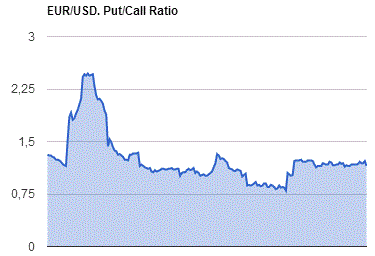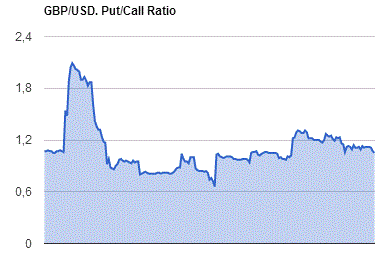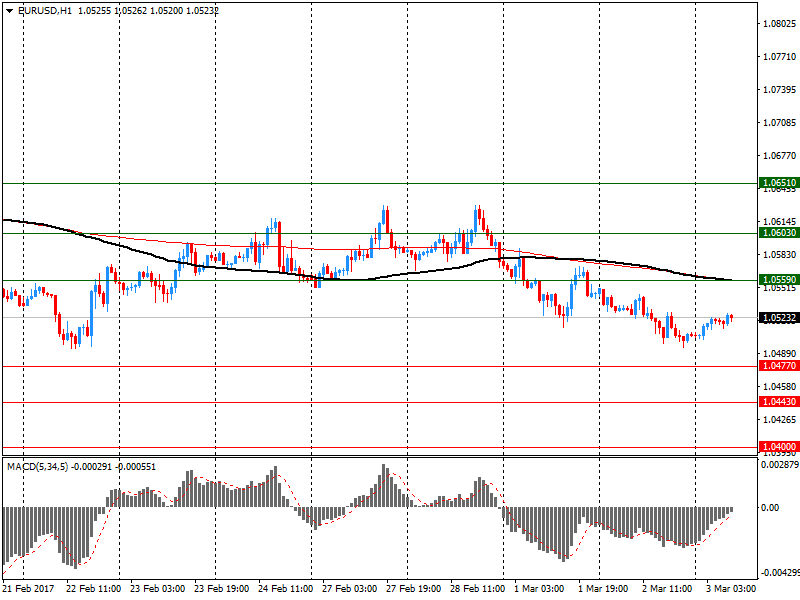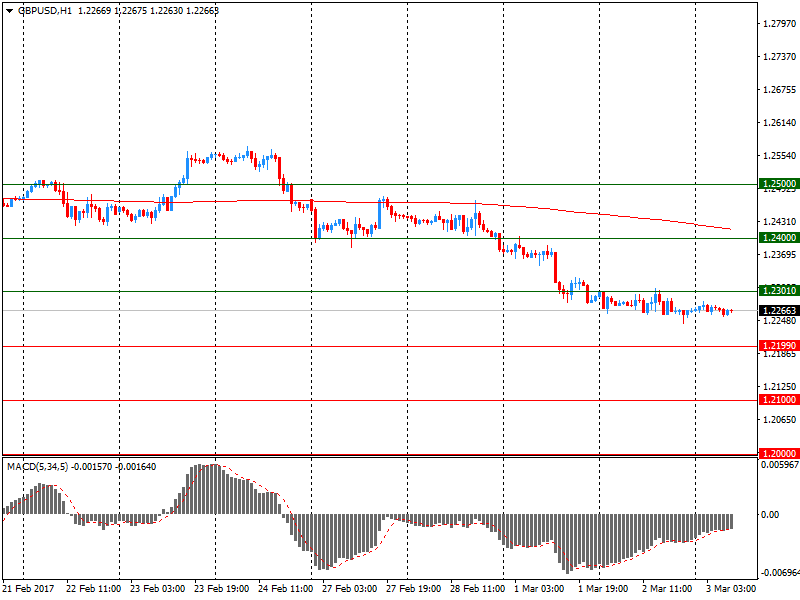Market news
-
15:41
Russian Central Bank says GDP growth in Q1 seen at 0.4-0.7 pct
-
15:31
Fed's Lacker, citing lessons of 1960s, sees value in pre-emptive rate hikes
-
Uncertainty about neutral rate makes assessing policy stance challenging
-
Stable inflation now is no guarantee for future stability
-
Central Bank independence cannot be taken for granted
-
Warns on costs of losing control over inflation
-
-
15:05
US non-manufacturing activity continued to rise
The report was issued today by Anthony Nieves, chair of the Institute for Supply Management (ISM) Non-Manufacturing Business Survey Committee: "The NMI registered 57.6 percent, which is 1.1 percentage points higher than the January reading of 56.5 percent. This is the highest reading since October 2015 and represents continued growth in the non-manufacturing sector at a slightly faster rate.
The Non-Manufacturing Business Activity Index increased to 63.6 percent, 3.3 percentage points higher than the January reading of 60.3 percent, which is the highest reading since February 2011, when the index registered 63.8 percent, reflecting growth for the 91st consecutive month, at a faster rate in February.
The New Orders Index registered 61.2 percent, 2.6 percentage points higher than the reading of 58.6 percent in January. This is the highest reading since August 2015, when the index registered 62.7 percent".
-
15:00
U.S.: ISM Non-Manufacturing, February 57.6 (forecast 56.5)
-
14:45
U.S.: Services PMI, February 53.8 (forecast 53.9)
-
14:15
Greek PM says we are close to a 'global solution' in bailout talks that should include debt relief
-
13:44
Option expiries for today's 10:00 ET NY cut
EURUSD: 1.0500 (EUR 846m) 1.0540 (242m) 1.0575 (319m) 1.0600 (551m)
USDJPY: 113.50 (1.7bln) 114.00 (1.8bln) 114.50 (1.7bln) 115.00 (2bln)
GBPUSD: 1.2300 (294m)
EUR/GBP: 0.8525 (EUR 632m)
AUDUSD: 0.7650-55 (AUD 706m)
EURJPY: 119.75 ( EUR 234m)
-
13:31
Nick Adams new book, Green Card Warrior, is a must read. The merit-based system is the way to go. Canada, Australia! @realDonaldTrump
-
12:15
U.S. Secretary of Commerce Ross says will be even more strong on import restriction - CNBC
-
I will meet with Cohn and Mnuchin weekly
-
Border adjustment is a powerful tool to balance the deficit
-
Fate of border adjustment tax unclear
-
Says Caterpillar search was part of ongoing probe
-
-
12:06
High event risk week ahead for EUR says BTMU
"EUR/USD - BEARISH BIAS - (1.0350-1.0700).
The euro is back under downward pressure against the US dollar in near-term although it still remains above the lows from January at around 1.0340. The US dollar is benefitting from more hawkish Fed rhetoric which has prompted the US interest rate market bring forward the expected timing of the next rate hike to this month, and increase the amount of expected tightening in the coming years. A rate hike this month is now seen as almost a done deal.
The main risks to this view in the coming week will be the speech from Fed Chair Yellen, and the release of the latest NFP report for February.
We do not expect Chair Yellen to alter current market expectations. A weaker than expected NFP report could prove more of a market mover although leading indicators are signalling that such an outcome is unlikely. There have also been positive developments in Europe over the past week which are helping to dampen downside for EUR/USD. Recent favourable opinion polls in both France and the Netherlands have helped to dampen the market's perception of European political risk. The ECB is expected to upgrade their inflation outlook at their upcoming meeting which could provide some support for the euro, although it is unlikely to signal a change to their loose policy stance at the current juncture".
Copyright © 2017 BTMU, eFXnews™
-
11:26
Macron seen beating Le Pen in run-off vote by 62 pct - Opinionway poll. EUR/USD trading up 30 pips
-
10:43
UK PM May says there is no economic case for breaking up the United Kingdom
-
No decisions currently taken by the Scottish parliament
-
-
10:10
Euro area retail sales fell 0.1% in January
In January 2017 compared with December 2016, the seasonally adjusted volume of retail trade fell by 0.1% in the euro area (EA19), while it rose by 0.1% in the EU28, according to estimates from Eurostat, the statistical office of the European Union. In December the retail trade volume decreased by 0.5% in the euro area and by 1.0% in the EU28.
In January 2017 compared with January 2016, the calendar adjusted retail sales index increased by 1.2% in the euro area and by 1.5% in the EU28.
-
10:00
Eurozone: Retail Sales (YoY), January 1.2% (forecast 1.6%)
-
10:00
Eurozone: Retail Sales (MoM), January -0.1% (forecast 0.4%)
-
09:33
UK services PMI below estimates in February. GBP/USD down 40 pips after the news
UK service sector firms remained in expansion mode during February, but growth momentum eased further from the 17-month peak seen at the end of 2016. The slowdown mainly reflected a softer pace of new business growth, which some respondents linked to more cautious spending among consumers. Business confidence nonetheless remained strong, with service providers indicating that optimism was little-changed from the post-referendum high recorded at the start of this year.
At 53.3 in February, the headline seasonally adjusted Markit/CIPS UK Services PMI Business Activity Index was down from 54.5 in January but still well above the 50.0 threshold that separates growth from contraction.
-
09:30
United Kingdom: Purchasing Manager Index Services, February 53.3 (forecast 54.1)
-
09:05
Growth of eurozone economic output accelerated to a near six-year record in February - Markit
At 56.0, up from 54.4 in January, the final Markit Eurozone PMI Composite Output Index rose to a 70-month high and was unchanged from the earlier flash estimate. Output growth was led by the manufacturing sector. Improved inflows of total new orders and new export business drove the rate of expansion in manufacturing production to its highest since April 2011.
Growth momentum also strengthened in the service sector, with business activity rising to the greatest extent for over five-and-a-half years
-
09:00
Recovery in growth momentum in the German service sector
February survey data from IHS Markit signalled a recovery in growth momentum in the German service sector. Having weakened to a four-month low at the start of 2017, the rate of expansion in total business activity accelerated and was slightly stronger than the trend shown over 2016 as a whole. Moreover, new business rose at the fastest rate since February 2016 and employment growth was the strongest since June 2011. The latest survey also revealed a further build-up of cost pressures at service providers, linked to salaries and fuel, which led to the sharpest rise in charges since April 2011.
The final Markit Germany Services PMI Business Activity Index rose to 54.4 in February from 53.4 in January.
-
09:00
Eurozone: Services PMI, February 55.5 (forecast 55.6)
-
08:55
Germany: Services PMI, February 54.4 (forecast 54.4)
-
08:50
France: Services PMI, February 56.4 (forecast 56.7)
-
08:29
Spanish service providers saw a much faster rise in business activity in February - Markit
Spanish service providers saw a much faster rise in business activity in February, supported by accelerated growth of new orders. Higher workloads and business optimism contributed to continued job creation. On the price front, the rate of input cost inflation remained elevated but companies continued to raise their output prices only marginally.
The headline seasonally adjusted Business Activity Index rose markedly to 57.7 in February from 54.2 in January, thereby signalling a much faster rate of growth in services activity than was seen at the start of the year. Moreover, the rate of expansion was the strongest since August 2015. Rising client demand and greater commercial activity were mentioned as factors driving the expansion of output.
-
07:32
Options levels on friday, March 3, 2017
EUR/USD
Resistance levels (open interest**, contracts)
$1.0651 (2821)
$1.0603 (3491)
$1.0559 (2469)
Price at time of writing this review: $1.0523
Support levels (open interest**, contracts):
$1.0477 (5050)
$1.0443 (3977)
$1.0400 (3517)
Comments:
- Overall open interest on the CALL options with the expiration date March, 13 is 73930 contracts, with the maximum number of contracts with strike price $1,0900 (4657);
- Overall open interest on the PUT options with the expiration date March, 13 is 82892 contracts, with the maximum number of contracts with strike price $1,0600 (5146);
- The ratio of PUT/CALL was 1.12 versus 1.14 from the previous trading day according to data from March, 2

GBP/USD
Resistance levels (open interest**, contracts)
$1.2500 (2385)
$1.2400 (778)
$1.2301 (792)
Price at time of writing this review: $1.2266
Support levels (open interest**, contracts):
$1.2199 (1654)
$1.2100 (1599)
$1.2000 (1951)
Comments:
- Overall open interest on the CALL options with the expiration date March, 13 is 34733 contracts, with the maximum number of contracts with strike price $1,2800 (3103);
- Overall open interest on the PUT options with the expiration date March, 13 is 37090 contracts, with the maximum number of contracts with strike price $1,1500 (3214);
- The ratio of PUT/CALL was 1.07 versus 1.09 from the previous trading day according to data from March, 2

* - The Chicago Mercantile Exchange bulletin (CME) is used for the calculation.
** - Open interest takes into account the total number of option contracts that are open at the moment.
-
07:31
Russian rouble opens 0.1 pct weaker vs dollar at 58.88
-
07:10
German retail sales up 2.3% on year
According to provisional data turnover in retail trade in January 2017 was in real terms 2.3% and in nominal terms 4.5% larger than that in January 2016. The number of days open for sale was 26 in January 2017 and 25 in January 2016.
When adjusted for calendar and seasonal variations, the January turnover was in real terms 0.8% and in nominal terms 0.2% smaller than that in December 2016.
-
07:01
Germany: Retail sales, real unadjusted, y/y, January 2.3% (forecast 0.7%)
-
07:00
Germany: Retail sales, real adjusted , January -0.8% (forecast 0.2%)
-
06:44
Japan national inflation in line with expectations, Tokio CPI down 0.3% in February
Nationwide consumer prices in Japan were up 0.4 percent on year in January, the Ministry of Internal Affairs and Communications said, cited by rttnews.
That was in line with expectations and up from 0.3 percent in December.
Core CPI, which excludes fresh food costs, added 0.1 percent on year - topping forecasts for a flat reading following the 0.2 percent decline in the previous month.
On a monthly basis, overall inflation added 0.1 percent and core CPI was up 0.3 percent.
-
06:41
The Caixin China Composite PMI data indicated a slight improvement in February
The Caixin China Composite PMI data (which covers both manufacturing and services) indicated a slight improvement in the rate of output expansion across China in February. The Composite Output Index rose from January's four-month low of 52.2 to stand at 52.6 in February, to signal a moderate increase in overall Chinese business activity.
The uptick in the headline index was supported by faster growth in Chinese manufacturing production during February. That said, the rate of output expansion was moderate overall, and weaker than those seen in the final quarter of last year. At the same time, services activity growth softened slightly in February, with the latest increase the slowest seen in four months. The seasonally adjusted Caixin China General Services Business Activity Index was down to 52.6 from 53.1 in January, to indicate a modest pace of growth.
-
06:39
The Australian Performance of Services Index moderated in February
The AustralianPerformance of Services Index (Australian PSI) moderated in February, with the index falling 5.5 points to 49.0 (results above 50 points indicate expansion, with higher numbers indicating a stronger rate of expansion).
This indicates stable conditions across the sector, following three months of growth. Only one of the five activity sub-indexes in the Australian PSI was above 50 points and indicating expansion in February (seasonally adjusted data). Supplier deliveries continued to grow (53.7 points), but at a slower pace than in January. The four other activity indicators indicated stable (around 50 points) or contracting (under 50 points) conditions in February
-
06:36
Fitch Ratings has affirmed the European Union's Long-Term Issuer Default Ratings at 'AAA'
Fitch Ratings has affirmed the European Union's (EU) and the European Atomic Energy Community's (Euratom) Long-Term Issuer Default Ratings (IDRs) at 'AAA' and Short-Term IDRs at 'F1+'. The Outlooks on the Long-Term IDRs are Stable. The issue ratings of EU's and Euratom's unsecured bonds have been affirmed at 'AAA'.
The affirmation of EU's and Euratom's ratings reflects the continuing strong commitment from the 28 member states to honour their contributions to the EU's budget, and more specifically, the support of the 'AAA'-rated member states.
-
05:02
Japan: Consumer Confidence, February 43.1 (forecast 43.7)
-
01:46
China: Markit/Caixin Services PMI, February 52.6 (forecast 53.3)
-

